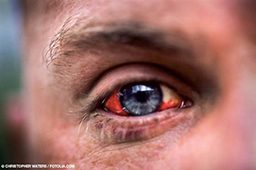Q: After completing a single dive this morning, my forearm is itchy and red. I’ve heard that decompression sickness can occur in the skin — like a rash. Is this true, and do you think it is something I should be worried about?
A: Identifying and diagnosing decompression sickness (DCS) can be difficult due to the similarity of unrelated disorders that can develop during or after a dive. But in general, any unusual symptoms that occur following a dive or series of dives are concerning and require medical evaluation to determine their cause.
It is well understood that DCS can affect a variety of tissues and organs. The skin is not exempt from DCS (cutaneous DCS or “skin bends”). In recompression treatment reports to DAN, cutaneous DCS makes up about 2 percent of treated cases, while in calls to DAN Medicine, it makes up more than 10 percent of suspected DCS cases. The primary manifestation of cutaneous DCS is a rash or mottled skin with a bruise-like “marbled” appearance. The color is typically dark red rather than pink, and the “rash” is usually not raised. It is often accompanied by tenderness and swelling in the affected area. There are occasional cases where itching sensations present without other symptoms or signs.
Cutaneous DCS may be confused with signs and symptoms of other origins. Sunburn, contact with hazardous marine life and combined effects of sand, wetsuits, sunscreen and seawater are a few examples of conditions that share symptoms with cutaneous DCS. Skin rash or mottling that occur after a dive are likely caused by DCS, while skin pain and itching that begin during the dive are more likely caused by contact with marine life. Although cutaneous DCS can affect any part of the body, it more commonly appears in the torso, buttocks, thighs or upper arms, areas possibly protected by a dive suit. Rashes due to the sun and contact with hazardous marine life are more likely to occur in exposed skin.
Cutaneous DCS manifestations often resolve spontaneously — sometimes within hours or days. Many cases respond well to surface-level oxygen first aid. However, DAN has observed that at least 20 percent of divers with suspected skin bends may also experience visual disturbances, weakness, confusion or other neurological symptoms that require recompression treatments. It is important that divers do not overlook these symptoms. Thus, a thorough medical evaluation and appropriate treatment of divers with suspected skin bends is always recommended.
— John U. Lee, MSDT, EMT, CHT, DMT, DAN medical information specialist
Q: After a recent dive I surfaced and noticed that my eyes were bloodshot and I had two “black eyes.” Have you ever heard of this?
A: Like the air spaces in our sinuses and ears, we must also equalize the air space in our masks as we descend. Failure to equalize the air space by exhaling through the nose can create a negative pressure within the mask. The negative pressure, in effect, creates suction. This is referred to as “mask squeeze,” which can cause varying degrees of barotrauma to the soft tissues of the face and eyes. The soft tissue around the eyes swells (periorbital edema) and discolors, manifesting as redness or bruising (ecchymosis). The eyes themselves may appear bloodshot.

Unless there is eye pain or visual problems present, there is no specific treatment for facial barotrauma. The injuries from a mask squeeze can take up to two weeks or more to resolve. The body will eventually reabsorb the ecchymosis and edema. The individual’s appearance may worsen before improving.
A physician or an eye specialist should address immediately any eye pain or visual disturbances such as blurred vision or partial loss of the visual field. These symptoms are rare with mask squeeze.
The best treatment for mask squeeze is prevention. Exhaling through the nose during descent (as done naturally, for example, with the Valsalva equalization technique) will minimize the risk of facial barotrauma.
— Neal Pollock, Ph.D.
Q: I have a life-threatening reaction to bee stings and have to inject myself with epinephrine if I am stung. Do I have to worry about reacting the same way to jellyfish?

A: According to marine toxicology experts, the venom found in stinging insects such as bees, wasps and hornets (hymenopterans) is different from the venom found in stinging marine life (cnidarians). There is no evidence of cross-reactivity between hymenoptera venoms and those in cnidarians. The possibility of experiencing an anaphylactic reaction to jellyfish, fire coral, hydroids or other marine life is very low.
There are rare individuals who do experience anaphylaxis with marine life envenomations. The reaction is believed to be separate and apart from an insect venom allergy. Individuals who have suffered anaphylaxis to a known allergen (e.g., insect venom, foods, drugs, etc.) should carry a prescribed “kit” and understand how to self-administer the medication.
Most marine life injuries are due to accidental contact and usually can be avoided. Gaining proficiency with and practicing good buoyancy control is essential. Minimizing the amount of exposed skin while diving is another important factor in prevention. If you are wearing a “shorty” wetsuit, a dive skin can be worn underneath for added protection. Educating yourself about creatures indigenous to the planned dive area will also help you identify and avoid sources of potential injury.
— Marty McCafferty, EMT-P, DMT-A, DAN medical information specialist
Q: Is it really riskier to dive if you’re over 50? At what age should I stop diving?
A: As long as a diver is fit enough to participate in the sport, there is no reason to discontinue the activity. The concern regarding diving after 50 has increased over the last several years simply because the average age of the diving population has increased. So many questions relating to older divers go back to a question of general health and fitness. One of the most common misconceptions regarding divers over 50 is that the age itself is the risk. That is not necessarily the case; it’s more a question of the fitness of the diver.
If a diver is in poor health, he is much more likely to encounter a dive injury or fatality than someone in good health. That is not necessarily age-related. If you have a 30-year-old car that has only 10,000 miles on it, you are much less likely to have an issue than if you are driving a 10-year-old car with 300,000 miles on it. Similarly, if you assume a 60-year-old diver in good health (eats well, exercises regularly, gets checkups, uses safe diving procedures) is at greater risk than a 35-year-old diver in poor health (smokes, drinks, doesn’t exercise, takes diving risks) only because of the chronological age, you are not taking into account the actual risk factors that are likely to come into play. As Indiana Jones once succinctly said, “It’s not the years, it’s the mileage.”
No matter what your age, DAN encourages regular checkups and an open relationship with your doctor to maintain a generally good state of health and fitness. Exercise on a regular basis, with an emphasis on both cardiovascular and strength training. Use safe diving practices, and if ever you don’t feel up to a dive, don’t do it. Be honest about your health, and remember that DAN stands ready to help answer your questions or assist with finding you a physician familiar with diving medicine.
— Nick Bird, DAN chief medical officer